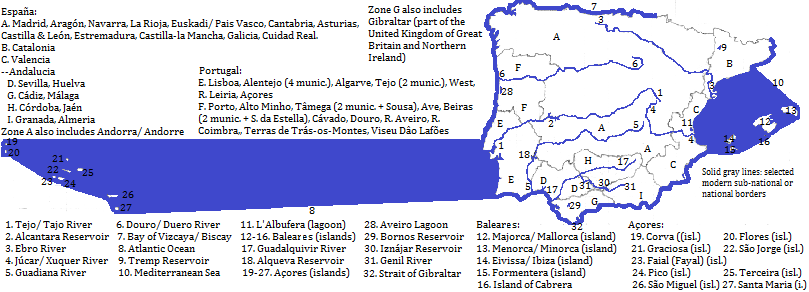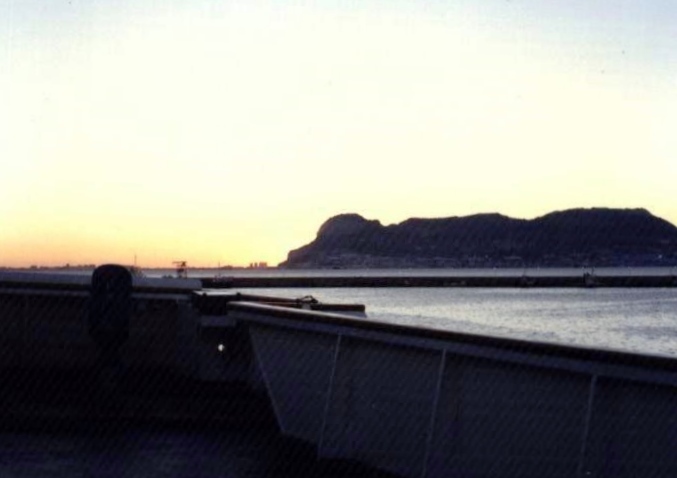España1--part: Andalucia, Aragón, Asturias, Baleares, Cantabria, Castilla-La Mancha, Castilla and Leon, Cateluña/ Catalonia, Ciudad Real, Euskadi/ Pais Vasco, Estredmadura, Galicia, Madrid Community and Province, Murcia, Navarra, la Rioja and Valencia; Portugal--part: Lisboa Metropolitan Area, Alentejo Central, Alentejo Litoral, Algarve, Alto Alentejo, Baixo Alentejo, Porto Metropolitan Area, Alto Minho, Alto Tâmego, Ave, Beira Baixa, Beirase and Serra da Estrela, Cávado, Douro, Aveiro Region, Coimbra Region, Tâmega and Sousa, Lezíria do Tejo, Médio Tejo, West (Oeste), Leiria Region, and Açores; Gibraltar (United Kingdom of Great Britain and Northern Ireland); and Andorra2
How is the land laid out?
This area consists of less than 600 thousand square kilometers consisting of one peninsula and two island chains.
The Iberian Peninsula of Europe consists of a plateau (the Meseta) with generally west-east ranges and tectonic river valleys.
In the northwest, fronting the Bay of Biscay is a wall: the Cantabrica Range. West of it are the Galician ranges, and east of it, the Pyrenees, which separate the peninsula from France. South of the Pyrenees is the Ebro.3
South of the Cantabrica is the Douro or Duero River.
An exception to the west-east rule of Iberian physiography is the Berico System of Mountains, which separates the Ebro from the other river valleys, and continues southeast.
The Central System, consisting of the Estrela, the Gredo and the Guadarrama Mountains, separates the Duero valley from the Tejo/ Tajo.4 This valley is separated from the Guadiana's by lower ranges like the Toledo.
The Guadiana valley is separated from the Guadalquivir's by the Morena Mountains. South of them are the Andalucian (or Baetic or Penibetica) Mountains, which reach their highest near the southeast coast in the Sierra Nevada.5
Besides the rivers already mentioned, there are the Mino or Minho in the northwest and the Segura and the Júcar6 in the east.
The notable lakes are reservoirs: the Alcantara on the Tajo is the largest.
East of the peninsula are the Baleares7 Islands; Mallorca8 is the largest.
Far to the west of mainland Portugal are the Açores,9 lying in three groups. The volcanic islands reach above 2,000 meters.
UNESCO World Heritage Sites for nature
Doñana National Park (adjacent to Sanlúcar de Barrameda, España)
Ibiza Biodiversity and Culture (Ibiza Town and elsewhere on the island, and on Formentara Island, España; the island is also a tourist attraction10)
Pyrénées-Mount Perdu (shared site between España and France)
Map

Who lives there?
The majority--almost six in ten--speak Spanish. Another almost two in ten speak Portuguese. Less than three in 20 speak the language known as Catalan or Valencian or Balear, depending on where it is spoken. More than one in 20 speak Galician. All of these are Ibero-Romance languages.
More than 19 in 20 are Roman Catholic Christians.
For a list of cities see Spanish cities and Portuguese cities.
UNESCO World Heritage Sites for culture, pre-dominantly Christian or modern secular
Alto Douro Wine Region, Portugal
Aranjuez Cultural Landscape, España
Burgos Cathedral, España
Catalan Romanesque Churches of the Vall de Boí (six locations in España)
Cathedral, Alcázar and Archivo de indios in Seville (Sevilla, España)
Central Zone of the Town of Angra do Heroismo in the Azores (Açores), Portugal
Convent of Christ in Tomar, Portugal
Cultural Landscape of Sintra, Portugal
Cultural Landscape of Serra de Tramuntera, (several locations on Majorca Island, España)
Heritage of Mercury, Almadén and Idrija (one location in España, one location in Slovenija)
Garrison Border Town of Elvas and its Fortifications, Portugal
Historic Centre of Évora, Portugal
Historic Centre of Guimarães, Portugal
Historic Centre of Oporto (Porto), Portugal
Landscape of the Pico Island Vineyard Culture, Portugal
La Lonja de la Seda de Valencia, España
Madriu-Parafira-Claror Valley, Andorra/ Andorre
Monastery of Alcobaça, Portugal
Monastery of Batalha, Portugal
Monastery of the Hieronymites and Tower of Belém in Lisbon (Lisboa), Portugal
Monastery and Site of the Escurial, España (the Escorial is also a tourist attraction15)
Monuments of Oviedo and the Kingdom of the Asturias (Oviedo and another location in España)
Mudédejar Architecture of Aragón (Teruel, Calatayud, Zaragoza and two other locations in España)
Old City of Salamanca, España
Old Town of Ávila with its Extra-Muras Churches, España
Palau de la Música Catalana and Hospital de Sant Pau, Barcelona, España
Poblet Monastery, España
Renaissance Monumental Ensembles of Ubeda and Baeza (Ubeda and another location in España)
Route of Santiago de Compostela (several routes in España; routes pass through Pamplona, Logroño, Burgos, León, Ponferrada, Santiago de Compostela, San Sebastián, Bilbao, Oviedo and Vitoria-Gasteiz)
Royal Monastery of Santa María de Guadalupe, España
San Millán Yuso and Suso Monasteries, España
Santiago de Compostela (old town), España
University and Precinct of Alcalá de Henares, España
University of Coimbra--Alta and Sofia, Portugal
Vizcaya Bridge (between Portugalete and Getxo, España)
Works of Antoni Gaudi (seven buildings in Barcelona, España, including Sagrada Familia, which is also a tourist attraction10)
Tourists also like: La Concha (beach) in San Sebastián (España); Lisboa (Portugal) generally (including its World Heritage Sites and more); and the Algarve Region of Portugal, which includes Faro, Lagos, Silves and Tavira.10
Who was there before?
In the early first millenium BCE, there were ancient cultures such as the Tartessos11 with sea contacts to other parts of the Mediterranean. The Basques, who were possibly related to the Vascones, may not have been south of the Pyrenees before the Romans noticed them north of the mountains, and if so, may have subsequently migrated south, or they may have been in Iberia for as long as they were in Gascogne.12
Punic13-speaking colonists from Carthage founded cities on the peninsula by the ninth century BCE. Their religion included worship of a god addressed as Baal. Celts moved into the notheast in the 7th century BCE and throughout the plateau in the next century. The 'Iberians' (a Roman catch-all term for the peninsula's early inhabitants) were assimulated to them. The Celtic religion included a priest class, the Druids. The Greeks founded cities starting in the 5th century. Their religion was headed by Zeus. When the Roman Republic defeated Carthage, it took over the Carthaginian colonies in Iberia, and subsequently conquered the entire peninsula. Some parts--like Andalusia--became highly Romanized, and Latin replaced the other languages. The initial Roman religion was polytheist, headed by Jupiter, whom they equated with Zeus. Later the Romans became Christian. The empire was invaded by Christian Germans and Alans14 in the first millenium CE. Some Germans moved on, but the last group, dominant by the 6th century, stayed. Next, the Arabs--or at least an Arab elite with a Berber army--conquered most of the peninsula in the 8th century. At least in the south, Arabic was supplemented by Mozarabic and Judezmo,15 both Latin dervied languages spoken respectively by Moslems and Jews.
Starting in the 9th century, the northern Iberian Christians who had not been conquered expanded southwards. The Moslems in the 12th century sought the aid of the new Berber dynasty in Morocco. Both the Christians and the Moroccans were genocidal, and the diversity of Spanish culture ended with a Christian victory. Moslem and Jewish refugees fled to other parts of Europe, and to North Africa and southwest Asia. The victors' language, Castillian Spanish, became dominant, though for a while, Leonese and Aragonese were distinct. Andalusian was the name for the Castillian dialects that developed in the south. The lingual holdouts--Galician-Portuguese (originally one language) and Catalan--were the Romance languages of other, eventually absorbed, Christian nations; these languages persist today.
UNESCO World Heritage Sites for culture, predominantly pre-Christian
Alhambra, Generalife and Albayzín (Granada, España; the Alhambra is also a tourist attraction10)
Archaeological Ensemble of Mérida, España
Archaeological Ensemble of Tárraco (Tarragona, España)
Archaeological Site of Atapuerca, España
Cave of Altamira and Paleolithic Cave Art of Northern Spain (15 locations in España)
Historic Centre of Córdoba, España (includes the Mezquita, a tourist attraction10)
Historic City of Toledo, España
Historic Walled Town of Cuenca, España (also a tourist attraction10)
Las Médulas, España
Old Town of Cáceres, España
Old Town of Segovia and its Aqueduct, España (the aqueduct is also a tourist attraction10)
Palmeral of Elche, España
Prehistoric Rock-Art sites in the Côa Valley and Siega Verde (shared set between España and Portugal)
Rock Art of the Mediterranean Basin on the Iberian Peninsula (758 locations in España; one is at Teruel)
Roman Walls of Lugo, España
Tower of Hercules (A Coruña, España)

View of Gibraltar
Around the Area
north, from the northeast
east and southeast
south
north, from the northwest, and west
Footnotes
1. Spain in English.
2. Andorre in French. While de facto independent, Andorra preserves a medieval ritual of paying feudal dues to the French government, representing the former king, and a Spanish prelate of the Roman Catholic Christian Church.
3. Ebre in Catalan-Valencian-Balear.
4. Tajo in Spanish, Tejo in Portuguese, Tagus in English.
5. Translates from Spanish as Snowy Mountains.
6. Xuquer in Catalon-Valencian-Balear.
7. Balearic in English.
8. Majorca in Castillian Spanish.
9. Azores in English.
10. www.touropia.com/tourist-attractions-in-Spain/ and www.touropia.com/tourist-attractions-in-Portugal/, both accessed 12/30/2015.
11. The Turdetani may have been descendents of the Tartessos culture.
12. Gascogne (Gascony in English) derives from 'Vascones', the Roman's word for Basques.
13. Punic and ancient Canaanite/ Hebrew constitute a dialect continuum. The dialect of Tyre, founder of Carthage, and that of Israel, as distinct from Judah, were mutually intellgible, but the dialect continuum was nonetheless divided into Hebrew and Punic at this political boundary.
14. The Alans' only descendents in the world are the Osete in the Caucasus. They are an Iranian group. They left no lasting cultural heritage in Iberia.
15. Ladino is related to Judezmo, and sometimes used as a synonym for it, but originally referred to a translator's language.


